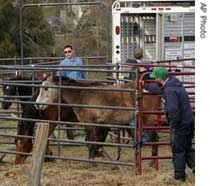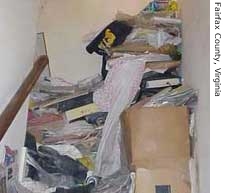VOA慢速英语 2007 0313b(在线收听)
VOICE ONE:
This is SCIENCE IN THE NEWS in VOA Special English. I'm Bob Doughty.
VOICE TWO:
 |
| Horses are seized from a Maryland farm in December. Officials accused the owner of hoarding about 70 horses, many of them sick and hungry. She denied mistreating them but said things ''got out of hand.'' |
(MUSIC)
VOICE ONE:
Many people in the United States are looking forward to the return of spring. During this season, millions of Americans do what is known as spring cleaning. They open windows in their homes to let in fresh air. They use cleaning products that make their homes smell nice. And they organize their belongings.
Some Americans have a strong desire to clean up their homes. This can also be called removing clutter. Clutter can be described as a disorganized collection of things. To remove clutter means to throw away the things you do not want. Then, organize the things you have decided to keep.
VOICE TWO:
In recent years, it has become easy to find information on how to attack clutter. There are books and even television programs on the subject. Specialty stores sell containers and boxes for storing things around the house.
Some Americans pay people to come to their home to remove clutter. Such people provide advice on what to keep and what to throw away. They also help with organizing things. However, the services of a professional organizer can be costly. Such services can cost up to two hundred dollars an hour.
(MUSIC)
VOICE ONE:
 |
| A home with a stairwell filled with useless things |
Hoarders are afraid to throw away things. Yet they continue to bring more and more things into their homes. They may save objects such as newspapers, clothing, and even old food.
VOICE TWO:
Hoarders live with so much clutter it may endanger their physical health. Dirt, insects, and bacteria that form over a period of time can cause sickness.
Safety experts say the homes of hoarders often are unsafe. A room filled with newspapers, for example, can cause floor supports to break down. In many cases, a room is filled from top to bottom with useless things. There is only a small space to walk from one end of the room to the other.
VOICE ONE:
One of the most famous hoarding cases involved two brothers in New York City. Homer and Langley Collyer were found dead in their home in nineteen forty-seven. Langley Collyer was buried under what appeared to be a mountain of old newspapers. The weight of the newspapers crushed him. Langley was Homer's caretaker. Medical experts believed Langley had been dead for several days before his brother Homer died of starvation.
Police found the home was filled with thousands of unused books, pieces of wood, and skins from large fruits and vegetables. The two brothers also saved pipes and very large automobile parts.
(MUSIC)
VOICE TWO:
Compulsive hoarding can have a severe effect on a family. Family members who share a home with the hoarder cannot understand why their loved one keeps so many useless and sometimes dangerous things. It prevents the family from enjoying their home. Experts say the hoarder should make a greater effort to keep the home clean and organized. However, it is not that simple.
Randy Frost is a psychologist at Smith College in Massachusetts. He also has studied hoarding. Mister Frost says it is more than a mental disorder. He says hoarding is a public health problem.
VOICE ONE:
Collecting waste, food or materials that can cause fires creates serious health risks. In the United States, hoarding violates laws that were created to protect public safety and property. Some cities have formed groups to deal with the problems caused by hoarding. Each group usually has representatives from one or more government agencies.
Agency officials say they often hear about hoarders from citizens who live near someone affected with the disorder. The citizens no longer want to see broken household equipment or old clothing lying on property near their homes.
VOICE TWO:
Persons suffering from compulsive hoarding syndrome do not only collect objects. Some collect cats, dogs or other animals. Most animal hoarders believe they are rescuing the animals with the purpose of caring for them. However, hoarders do not realize when they have too many animals. They are really doing more harm than good. They may not be able to provide medical care for the animals. Some animals may not be washed or fed.
Officials have been shocked at the condition of the homes of animal hoarders. Floors were covered with animal wastes. Infectious diseases were a problem. Some animals were found starving, while others had died.
An animal hoarder usually collects other things, such as clothing or magazines. Experts suspect that many hoarders have had uncaring parents or disorderly lives as children. The animals serve as a way for hoarders to get the love they always wanted.
(MUSIC)
VOICE ONE:
Compulsive hoarding syndrome affects an estimated one million people in the United States. Compulsive hoarding is most commonly connected to obsessive-compulsive disorder, or O.C.D. This disorder causes people to have ideas that interfere with their daily activities. Such persons act on these ideas, even when they know the resulting actions are senseless.
For example, fear of being dirty may cause persons with O.C.D. to wash their hands again and again. They may inspect things repeatedly, like making sure all electrical devices are turned off.
VOICE TWO:
Sanjaya Saxena is director of the Obsessive-Compulsive Disorders Program at the University of California at San Diego School of Medicine. He says hoarders have high levels of uneasiness, depression and a need to be perfect.
In a recent paper, Professor Saxena reported discovery of an effective treatment for patients who suffer from compulsive hoarding. The study included seventy-nine patients with O.C.D. Thirty-two of them had compulsive hoarding syndrome. The study found that the drug paroxetine was effective in treating those suffering from compulsive hoarding. Researchers say the study suggests that more controlled studies of medicines to treat the disorder could offer more improvements.
VOICE ONE:
Professor Saxena also led an earlier study of the disorder. In that study, he and his team used images from a process called positron emission tomography to measure brain activity. They compared images of the brains of hoarders to those from other persons with O.C.D.
The hoarders had lower activity in an area of the brain called the anterior cingulated gyrus. This area helps to control decision-making and the ability to solve problems. The study suggested that different medicines could improve the success of treatment.
VOICE TWO:
Recently, another study identified a possible genetic marker for compulsive hoarding. The American Journal of Psychiatry published results of the study.
The lead researcher was Jack Samuels of the Johns Hopkins Hospital in Maryland. He and his team studied more than two hundred families with O.C.D. The researchers found evidence suggesting that an area of genes on chromosome fourteen was linked with compulsive hoarding. They said the linkage became stronger when two or more family members affected with compulsive hoarding were tested.
VOICE ONE:
Treatment of compulsive hoarding is very difficult. It may involve medicines and working with a mental health expert. The expert helps hoarders to understand their actions of saving worthless things. Patients are taught to develop a plan for organizing. They learn how to decide what to throw away. They learn to resist the urge to bring home more things.
Experts suggest taking a picture of the area to be organized before and after the work is completed. They say this will provide the patient with a feeling of progress. They also say the treatment program, changes in the way of thinking, and improved decision-making skills will help the patient for a long time.
(MUSIC)
VOICE TWO:
SCIENCE IN THE NEWS was written by Lawan Davis. Brianna Blake was our producer. I'm Faith Lapidus.
VOICE ONE:
And I'm Bob Doughty. We hope you can join us again next week for more news about science in Special English on the Voice of America.